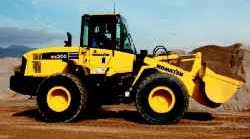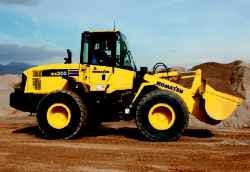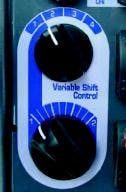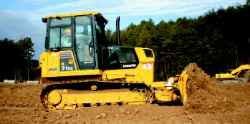Komatsu America's new WA200-5 wheel loader takes full advantage of innovative design using hydraulics.
Closed-loop electrohydraulic control, load sensing, and flow sharing have allowed the most recent generations of construction equipment to leave older designs in the dust. Load sensing and flow sharing make machines more productive and efficient. Electrohydraulic control not only makes machines more operator friendly and productive, but aids diagnostics and troubleshooting.
Despite sophisticated electronic controls that make hydraulics more versatile than ever, it's still the muscle of hydraulics that gets the job done quickly and efficiently. Komatsu America, Vernon Hills, Ill., has taken full advantage of this benefit, but also demonstrates with its new WA200-5 wheel loader that hydraulics doesn't have to be leaky or noisy.
Loader showcases benefits of hydraulics
Komatsu's WA200 wheel loader provides a study in mobile hydraulics to improve efficiency and productivity. Starting with its diesel engine, which provides 119 hp at 2000 rpm, a hydraulic fan drive keeps the engine running at a temperature that maximizes fuel economy while minimizing emissions.
The hydraulic fan drive is controlled by a microprocessor that regulates fan speed according to engine temperature. As engine temperature increases, the microprocessor signals a hydraulic pressure control valve to increase pressure to the hydraulic fan motor. Because the fan is driven as a centrifugal load, pump pressure correlates directly to fan speed (air flow). This allows controlling fan speed by regulating pressure, rather than flow — the traditional way to control speed. The fan drive maintains engine temperature within a narrow window independent of ambient air temperature.
Tight control of engine temperature is important because it has a strong influence on fuel economy. Should engine temperature drift above or below this window, fuel economy would suffer. Temperature also affects emissions. So this close control of engine temperature plays an important role in the engine's certification for Tier 2, EU, and Japanese emissions.
Furthermore, to help keep the hydraulic fan drive running efficiently, it swings out away from the radiator for easier, more effective cleaning. Also, the entire cooling system is isolated from the engine to provide efficient cooling and quiet operation.
HST is versatile, efficient drive
The WA200 features 4-wheel drive with wheels driven through axles with differential gearing. Each differential is powered by a drive shaft from a transfer case that is driven by an electronically controlled, dual-motor hydrostatic transmission (HST). The HST itself consists of a variable-displacement axial-piston pump that is capable of maintaining pressure to nearly 3000 psi. Flow from the hydrostatic pump flows to one of two variable-displacement axial-piston motors — one for driving the low-speed input of the transfer case and one for the high-speed input. The combination of the high-torque engine and HST reduces fuel consumption by 15% when operating in the low-speed mode. When high torque is needed for aggressive digging, climbing, or initiating movement, the pump feeds both motors.
The variable HST provides quick travel response and automatically adjusts to the tractive effort demand for maximum power and efficiency. It also eliminates the need to shift gears, which improves productivity by allowing the operator to focus full attention on the task at hand.
An electronic shift control makes it easy to reverse direction of the loader. The operator can use either a forward-reverse switch mounted on the loader's multi-function control lever or activate a control lever mounted to the steering column without having to remove his or her hands from the steering wheel.
The operator chooses between any of four speeds by dialing a speed range selector switch. Setting the speed control switch to 1 or 2 provides aggressive digging, quick response, and rapid motion of implements. When set to 3 or 4, the control still provides power for aggressive digging, but with much faster travel speed.
A variable shift switch allows the operator to adjust machine speed, which proves useful in confined loading applications. With the variable shift control in 1, the operator can adjust travel speed using the variable shift control switch to match machine speed and hydraulics to the travel distance. This feature can also be an advantage when operating a motorized implement, such as a broom or snow blower.
The WA200 also has a traction control system, activated by the push of a button. The traction control system automatically reduces tire slippage by limiting the torque capability to 50% of maximum. This is accomplished simply by controlling output pressure of the hydrostatic pump.
Deceleration and braking
When the loader decelerates, the HST system acts as a dynamic brake for the mechanical drive. In fact, the dynamic brake can hold the loader in position on most workable slopes. This can be an advantage in stockpiling and ramp loading. As the loader gains ground speed, the torque demand decreases, so a clutch disengages the low-speed motor from the drive train.
When the loader descends a slope of 6° or less, maximum travel speed is automatically restricted to roughly 24 mph. This is accomplished by sensing the travel speed and limiting flow from the HST pump and motor. If speed of the loader reaches 24 mph, a caution lamp informs the operator to reduce travel speed.
Braking is provided by hydraulically actuated wet multi-disc brakes on all four wheels. Wet-disc brakes provide more effective braking in a smaller space than standard dry disc brakes. Because the wet discs are immersed in oil, they dissipate heat much faster than dry brakes do. Furthermore, because multiple discs are used, surface area of the discs — which correlates to braking torque — far exceeds that of a single dry disc brake. The parking brake is a multi-disc design immersed in oil, but it is located on the transfer box output shaft. An independent emergency braking system is also provided at front and rear axles.
Another control element is an inching pedal, which provides simultaneous control of hydraulic implement and travel speeds. Depressing the inching pedal decreases pump flow to the motors. As a result, ground speed decreases. The operator then uses the accelerator pedal to increase flow to hydraulic implements. Depressing the inching pedal further activates the service brakes.
Other hydraulic features
Steering is accomplished through a pair of 2.8-in. bore, 17.8-in. stroke cylinders powered by a hydraulic pump capable of delivering 25.1 gpm. The system provides full hydraulic power to pivot wheels 40° left or right and is independent of engine speed.
The boom is actuated by a pair of 4.7-in. bore, 26.5-in. stroke cylinders, while a 5.1-in. bore, 19.4-in. stroke cylinder actuates the bucket. These cylinders are controlled through dual-spool valves with Komatsu's Proportional Pressure control (PPC) feature. The PPC feature allows fine control and reduces the effort and travel distance the operator must execute to control the machine.
The steering, boom, and bucket cylinders all contain buffer rings mounted inboard of the rod seals. The buffer rings reduce the load on the rod seals and extend cylinder life by 30%, improve overall reliability, and reduce leakage. Also contributing to leakage prevention are flat-face O-ring seals on hydraulic hose connections throughout the machine. All hydraulic functions are served by a 15.3-gal reservoir.
Noise has been given higher priority in today's construction equipment. To limit in-cab noise to 70 dBA, the loader's engine, hydraulically driven fan, and hydraulic pumps are mounted on rubber cushions, which dampens vibration and reduces noise.
Crawler dozer is HST all the way
The D31's HST consists of a dual path hydraulic closed-center load-sensing system (CLSS). Each circuit is driven by a variable-displacement piston pump that transmits power to a 3-speed variable displacement piston motor. A charge pump keeps fluid pressurized at the inlet of the pump no matter what the orientation of the dozer. This eliminates the risk of cavitation (air in the inlet oil), which can cause serious damage to the pump.
Output power from each motor drives a double-reduction planetary gear final drive, which, in turn, powers each track. The hydraulic motors and final drives are mounted inside the track shoe width to protect them from damage from rocks, stumps, and other obstacles.
The versatile transmission allows operators to choose between traditional 3-speed or infinite speed change to 5.3 mph. The CLSS also controls the dozer blade, and blade lever stroke is directly proportional to blade speed, regardless of load and travel speed. A 3-spool control valve performs blade lift, blade tilt, and blade angle.
The HST not only propels the D31, but provides dynamic braking as well. Dynamic braking is accomplished through the hydraulic system, and wet, multiple-disc brakes
Despite all the power available to the D31, its hydrostatic steering is precise, thanks to Komatsu's Palm Command Control System (PCCS). The PCCS uses a joystick for all directional movements — left, right, and counter-rotation. Hydrostatic steering eliminates the need for the clutches and brakes necessary with mechanical drives.
Rounding out the overall system is an electronic monitoring system that keeps close tabs on critical parameters, such as HST speed range, HST oil temperature, and HST charge filter caution lamp.





